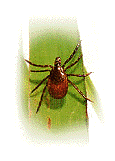Prevent Lyme Disease

What steps can be taken to prevent Lyme disease?
Preventing Lyme disease takes thoughtful preparation. It requires that you prevent ticks from getting on your skin. When you go outside into areas where ticks can be found, it is helpful to:
- Avoid tall grass and over-grown, brushy areas.
- Stay in the middle of the trails when hiking in the woods.
- Wear light-colored clothing so the ticks can be easily seen.
- Wear long pants to provide a better barrier than shorts.
- Tuck pants into socks creates a barrier and ticks will not be able to get to your skin.
- Wear long-sleeved shirts and closed shoes when in tick infested areas.
- Use insect repellent to significantly reduce the chance of tick bites and the transmission of Lyme disease and other tick-borne diseases.
- DEET is the primary active ingredient in most tick repellents and is considered the most effective. It must be used as directed on the container.
- Examine yourself, your children, and pets for ticks when returning indoors.
- Remove feeding ticks as soon as possible. Ticks need to feed for 24 hours before transmission occurrs.
- When returning indoors, shower using a wash cloth or buff to remove walking ticks on your body. Ticks have a tendency to walk on the body before biting and feeding.
- Talk to your veterinarian to find out how to protect your pets from tick bites.
The sooner ticks are removed from the body the less likely you will get Lyme disease.
Most people with Lyme disease do not remember being bitten by a tick because a tick bite is not felt; unlike mosquito bites. Ticks are very small and difficult to see, and many people do not get the expanding red rash that resembles a bull's eye and identifies Lyme disease infection.
If you have any signs or symptoms of Lyme disease, especially after a tick bite, contact your doctor right away.
To contact the Epidemiology and Emerging Infections Program, please call 860-509-7994.

